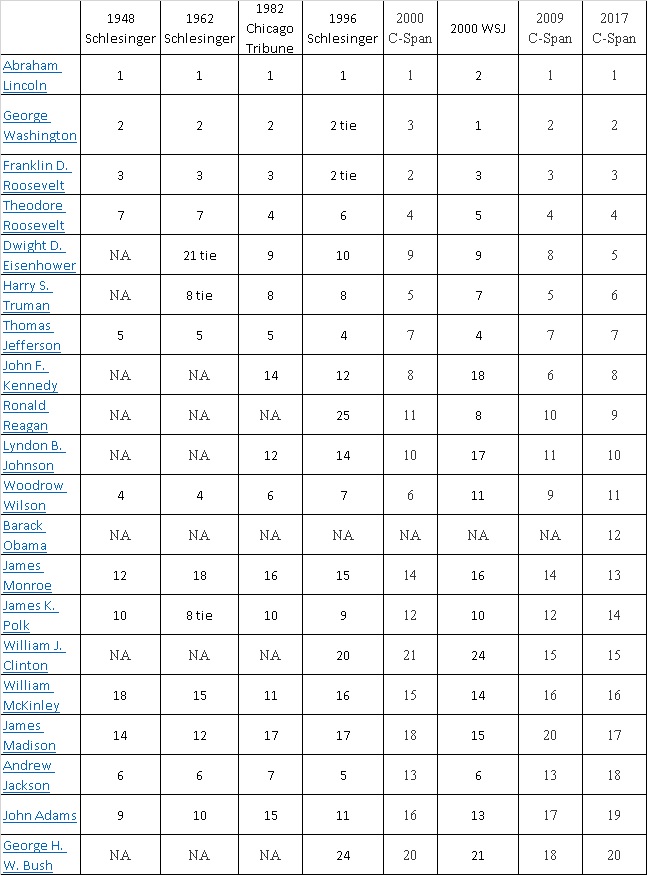Fifty Year Retrospective
Historian Arthur M. Schlesinger published a ranking of U.S. presidents in 1948 and again in 1962 based upon opinions of 75 historians. He used a scale of minus 2 to plus 4, then averaged the results. The Chicago Tribune published a ranking by 49 historians in 1982, and Arthur Schlesinger Jr. produced a ranking in 1996 by a process similar to his father’s. The Wall Street Journal conducted a survey in 2000 of 132 “prominent professors of history, law, and political science.” (See table below.)
C-SPAN, the nonprofit public service cable television network, conducted a survey in 2000. The survey of nearly 100 historians and biographers ranked 43 U.S. presidents on ten individual leadership characteristics: Public Persuasion; Crisis Leadership; Economic Management; Moral Authority; International Relations; Administrative Skills; Relations with Congress; Vision/ Setting an Agenda; Pursued Equal Justice For All; Performance Within Context of Times. C-SPAN conducted subsequent surveys in 2009 and 2017 using the same ten characteristics.
Methods varied among the eight rankings, and yet positions within the lists are fairly consistent. Variations over time for individual presidents could reflect methodological differences, but approval of a past president can change over time. Ronald Reagan, for example, had widely varying rankings. Was he less respected in 1996 during the Clinton administration when he was ranked 25th than in 2017 during the Trump administration when he ranked 9th?
Dwight Eisenhower’s rankings cover 55 years and a variation as wide as Reagan’s. Eisenhower left office in 1961, and in 1962 the first Schlesinger ranking placed him at 21st, tied with Chester Arthur. Eisenhower was the last of 34 presidents ranked in 1962, thus his rank as 21st placed him in the bottom half of the rankings.
Eisenhower won by a landslide in 1952, after returning as a hero of World War II. In his eight years in the presidency, he achieved an armistice in the Korean War and encouraged peaceful use of atomic energy at the U.N., while checking the spread of communism. He oversaw the creation of the interstate highway system. He set up the Civil Rights Commission and the National Aeronautics and Space Administration (NASA). In his farewell address in 1961, he warned the nation of the dangers of the “military industrial complex,” a warning that has never lost its relevance.
So why, in 1962, was Eisenhower ranked 21st best president out of 34? Eisenhower was followed by John Kennedy, a man 27 years his junior. Perhaps the youth, energy and popularity of the new resident of the White House in 1962 skewed the thinking of those 75 historians.
In subsequent rankings, Eisenhower consistently ranked no lower than 10th, and most recently, 5th in the 2017 C-SPAN survey. In 1966, Eisenhower wrote to James Hagerty, his White House press secretary, that he believed the scholars of the 1962 ranking did a poor job, rewarding past presidents for eloquence over performance.
Eisenhower died March 28th, 1969, 50 years ago. Fifty years from now how will historians rank the current president?

